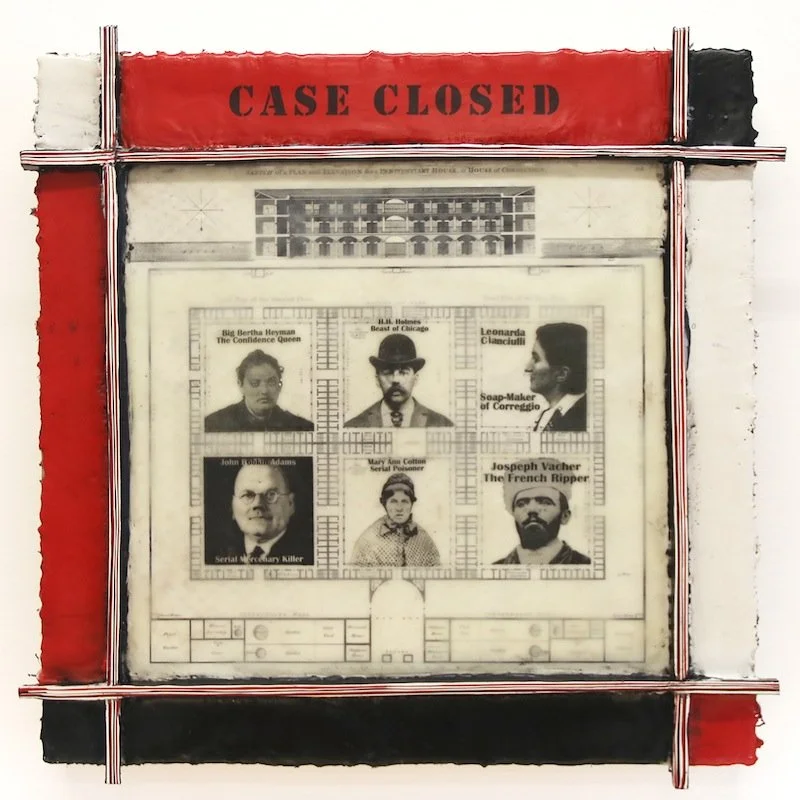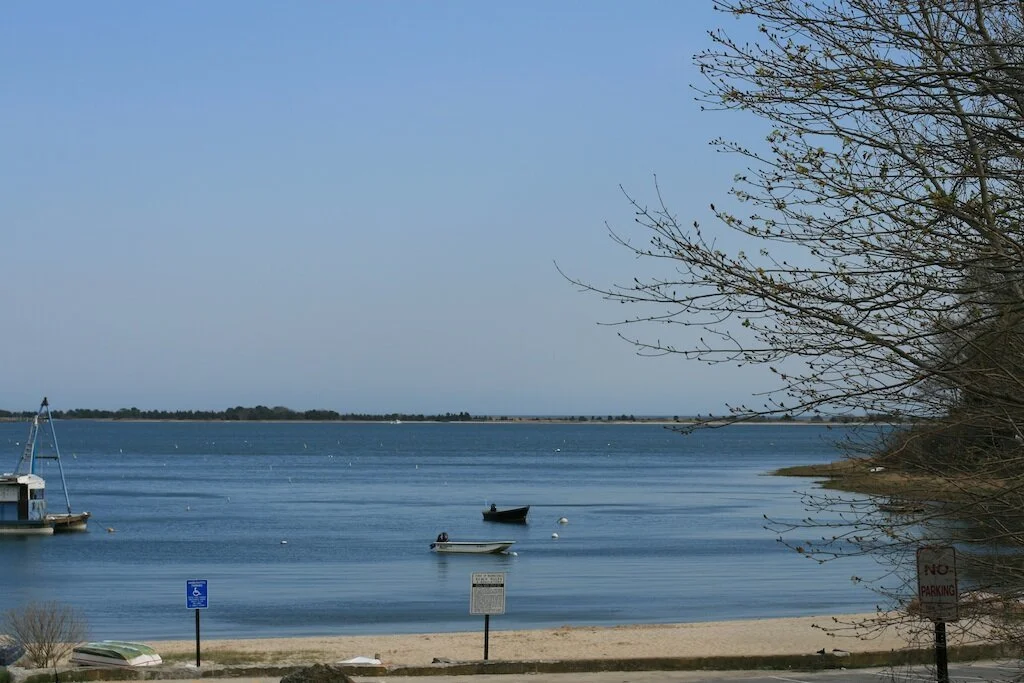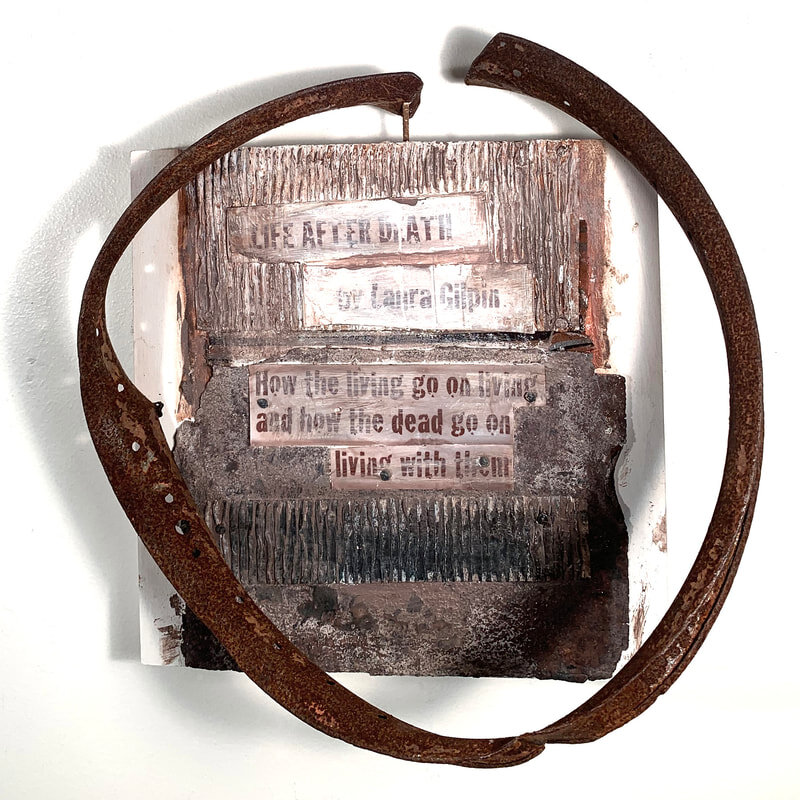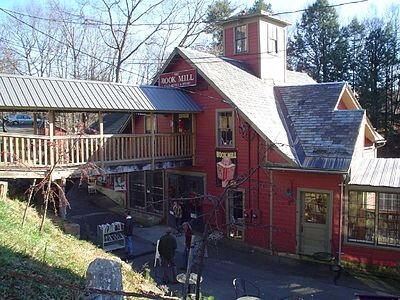
‘I celebrate plants’
“Weeds in Black” (encaustic), by Debra Claffey, who’s based in New Boston, a small town in southern New Hampshire. She’s a member of New England Wax (newenglandwax.com).
She says:
“My experience in horticulture and organic land care has led me to focus in on the plant world and the assaults on the soil, biodiversity of plant species, and the protection of native flora. I celebrate plants: their great age and history on the planet, their intelligence and successful adaptions, their beauty of form, shape, and infinite color. I marvel in our new knowledge of their ways of communication, of making themselves attractive to us and other species, and the trading of ‘goods and services’ that goes on between plants, fungi, bacteria, insects, birds, and even us mammals.’’
New Boston in 1875. Below is an edited version of the Wikipedia entry on the town, which was chartered in 1736.
“In 1820, the town had 25 sawmills, six grain mills, two clothing mills, two carding mills, two tanneries and a bark mill. It also had 14 schoolhouses and a tavern. The Great Village Fire of 1887, which started when a spark from a cooper's shop set a barn on fire, destroyed nearly 40 buildings in the lower village. In 1893, the railroad came to New Boston, and farm produce was sent by rail to city markets. Passenger service was discontinued in 1931, and the tracks were removed in 1935. Today the former grade is the multi-use New Boston Rail Trail.
“The town {along with the adjacent towns of Amherst and Mont Vernon} is home to the 2,800-acre New Boston Space Force Station, which started as an Army Air Corps bombing range in 1942. By 1960, it had become a U.S. Air Force base for tracking military satellites. In July 2021, the facility was given its current name and began operating as part of the United States Space Force. New Boston was also home to the Gravity Research Foundation from the late 1940s through the mid-1960s. Founder Roger Babson placed it in New Boston because he believed it safe from nuclear fallout should New York or Boston be attacked.’’
New Boston Space Force Station
Creative criminals of yore
“Case Closed” (encaustic with image transfers), by Providence-based artist Angel Dean. She is a member of New England Wax (newenglandwax.com)
Peddle faster
“Resistance” (encaustic on panel), by Hélène Farrar, of Manchester, Maine, from her “What We Carry’’ series. Her work will be shown in New England Wax’s (newenglandwax.com) show “Layering: The Art and Experience of Hot Wax,’’ at the Cotuit (Mass.) Center for the Arts June 26-Aug. 7.
Rope's Beach, in Cotuit, looking onto Cotuit Bay. Cotuit has drawn many artists to work and show there , mostly in the summer, since the late 19th Century.
Part of this long popular summer-cottage lake is in Manchester, where Ms. Farrer lives and works.
The lights in the woods
“Maine Winter” (encaustic and oil), by Camille Davidson, a painter who lives on a lakeside cabin in Maine. She operates a gallery in Readfield, Maine. Hit this link.
She says in newenglandwax.com that she is “inspired by the shifting lights that occur in the woods and the seasons that change around me.’’
'Three aspects of time'
“Under the Juniper Tree’’ (encaustic) by Boston-based painter Lola Baltzell, in the “Brilliance and Celebration” show at Galatea Fine Art, Boston, through Oct. 31. She is a member of New England Wax (newenglandwax.com).
She says:
"This piece represents the past, the present and the future. Three panels, three aspects of time. Mostly I try to stay in the present. I feel like a refugee who has fled the homeland. I now live in a world that feels so foreign. The past — does it exist? It feels like ‘the old world’: The future? I'm trying to hold a sense of possibility."
The gallery says: “Lola Baltzell's works are uninhibited, yet carefully structured. It is not imposed, but appears as a reflection of natural order. Microbes, cells, direction of energy all serve to inform the surface of her works.’’
See:
galateafineart.com
Dead or alive, we're in this together
“Circle Round “ (encaustic, acrylic, cardboard, paper, wood panel, rusty bicycle wheel), by Sue Katz, an artist living in the Pioneer Valley area of western Massachusetts. Her Web site is suekatzart.com. She is a member of newenglandwax.com
The Pioneer Valley (part of the Connecticut River Valley) from space, with Springfield toward the bottom of the photo and Northampton-Amherst toward the top.
The front entrance to The Bookmill, in Montague, Mass., in the Pioneer Valley
The story beneath
Work by Stephanie Roberts-Camello (encaustic relief over book pages and casein)
She writes:
“Layers of wax literally cover up the past. Revealed, exhumed, manipulated, up-ended, exposed, all of these actions give me a sense of freedom, and the ability to step outside myself. Seemingly destructive to the surface, the peeling plays a positive roll in removing a build up and seeing what has been lying dormant. The depth created working this way is jarring to me, confrontational, alluring and frightening. There is risk involved, but the presence of this relief work conveys a sense of resilience and life which keeps me returning. It speaks with a boldness and beauty which is also fragile. This opposition between image/content and material is the catalyst for the development of my encaustic relief series. This work continues to evolve as I find new ways to shed light on subjects I want to confront.’’
Quaker meeting house in Pembroke. Southeastern Massachusetts was an early center for Quakers in America.
The artist, a member of New England Wax (newenglandwax.com) lives in Pembroke, Mass., where she and her husband have a business called Queen Bee Honey.
The geography of the once rural, agricultural and fishing town Pembroke, now a Boston suburb, is dominated in the northern part by streams flowing through woods that once provided the lumber for the North River's shipbuilding industry. These streams are famous for their fish runs, including of herring, blue fish and striped bass.
The southern half is dominated by several ponds and Silver Lake, where the towns of Pembroke, Kingston, Plympton and Halifax meet.
Early industries also included smelting bog iron and cutting and selling ice from the town’s many bodies of fresh water.
From Marshfield, looking across the North River toward Pembroke. It’s a fine fishing area.
















